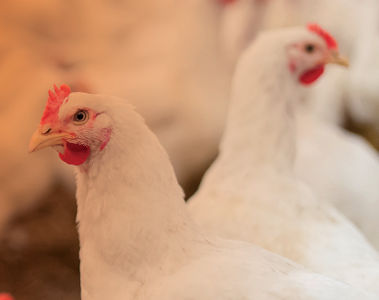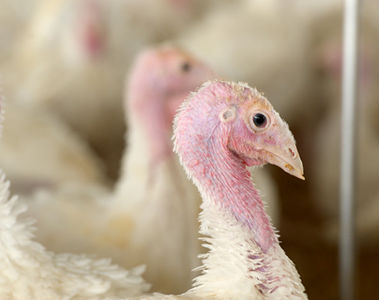The U.S. turkey industry plays a significant role in the nation's agricultural economy, with over 216 million turkeys produced annually, contributing to an economic impact of $103.4 billion (National Turkey Federation, 2019). Leading production states include Minnesota, North Carolina, and Arkansas, collectively yielding 5.55 billion pounds of turkey meat in 2023. Turkey meat production in 2021 was recorded at 5.558 billion pounds, underscoring its importance as a dietary staple (USDA ERS, 2024). With key export markets in Mexico and Canada, the industry remains a crucial component of U.S. agriculture. To maintain industry health, it is essential to understand diseases such as Highly Pathogenic Avian Influenza (HPAI), Avian Metapneumovirus (aMPV), and Turkey REO virus.
Highly Pathogenic Avian Influenza (HPAI) in Turkeys
HPAI, caused by influenza Type A viruses, leads to high mortality rates and substantial economic losses. Infected turkeys show symptoms such as sudden death, lethargy, lack of appetite, decreased egg production, swelling of the head, neck, and eyes, coughing, sneezing, and nasal discharge (Mumu et al., 2020; Swayne et al., 2000). The disease progresses rapidly, often resulting in significant flock mortality.
Since the outbreak began on February 8, 2022, approximately 90.89 million birds have been affected by HPAI across the United States, with 1,139 flocks (486 commercial and 653 backyard) spanning 48 states (USDA APHIS, 2024b). By the end of 2023, turkeys represented over 70% of the affected birds, causing significant financial strain due to the depopulation of millions of birds (Patyk et al., 2023). In 2024, the virus continues to spread, particularly in Minnesota, North Carolina, and Indiana, with severe economic repercussions impacting turkey product availability and livelihoods within the industry (USDA APHIS, 2024b).
Transmission of HPAI occurs through direct contact with infected birds or contaminated environments, with risk factors including poor biosecurity and wild birds near poultry farms. Depopulation remains the primary outbreak management method, while stringent biosecurity measures are crucial for protecting flocks from infection (Patyk et al., 2023).
Avian Metapneumovirus
Avian Metapneumovirus (aMPV) causes respiratory illness and reproductive issues in turkeys. Identified in the 1970s, aMPV has four known serotypes: A, B, C, and D (MacLachlan et al., 2017). Infected birds show respiratory distress, nasal discharge, swollen sinuses, and decreased egg production (Amine et al., 2023; Pringle, 1998), with high mortality rates and significant economic losses associated with outbreaks (Rautenschlein, 2020).
Diagnosis involves serology and PCR tests. There is no specific treatment for aMPV, making prevention and control paramount. Strategies include biosecurity, vaccination, and managing secondary bacterial infections with antibiotics (Nicholds et al., 2020). Both live and inactivated vaccines are used in areas where aMPV is common. Recent outbreaks have been reported in Virginia, North Carolina, and California, with increased serologic positives noted since early fall 2023. The National Veterinary Services Laboratories (NVSL) confirmed Avian Metapneumovirus subtype B in turkeys and broilers from Virginia, North Carolina, and subtype A in turkeys from California. The increase in serologic positives since late 2023 has been linked to high mortality events. Ongoing surveillance, improved diagnostics, and effective biosecurity practices are essential to mitigate the disease's impact (USDA APHIS, 2024a).
Turkey REO Virus
The REO virus is a significant concern due to its widespread impact and limited treatment options. This virus primarily affects the leg joints of turkeys, causing lameness (Sharafeldin et al., 2016), swelling, and increased joint fluid. Symptoms include difficulty walking, lethargy, and swollen hocks, leading to welfare issues and economic losses due to increased culling, mortality, and reduced growth rates (Porter, 2018).
A survey by the National Turkey Federation (NTF) indicated that the REO virus consistently ranks among the top concerns for turkey producers. In 2019, approximately 2% of turkeys and 5% of toms were affected, resulting in higher production costs due to increased mortality and reduced feed efficiency (Graber, 2024). Transmission occurs vertically and horizontally, with oral exposure allowing the virus to infect intestinal epithelial cells and potentially spread to the heart, liver, intestines, and tendons (Nicholds et al., 2020).
Currently, turkeys have no specific treatment for the REO virus (Kumar et al., 2022). Management focuses on prevention and control through biosecurity measures, improved flock management, and ongoing vaccination research. The NTF Foundation actively funds research to develop better diagnostic tools and vaccines to reduce REO virus prevalence and impact (Graber, 2024).
Conclusion
The U.S. turkey industry's fight against HPAI, aMPV, and REO virus underscores the need for stringent biosecurity, advanced research, and innovative technologies. Comprehensive biosecurity protocols are crucial for preventing outbreaks, while investment in vaccines and diagnostic tools enhances disease management. These efforts are vital for safeguarding flock health, maintaining productivity, and ensuring the industry's economic viability. Continuous advancements in prevention and control will sustain and strengthen turkey production against emerging health challenges.



